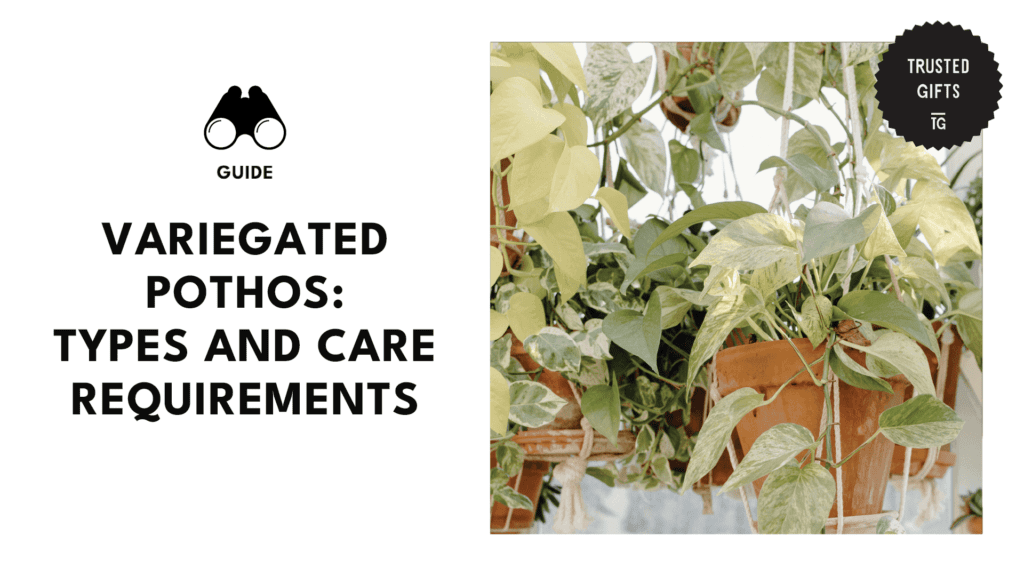There’s no denying that plain green plants are stunning. But the splash of color that variegated plants have, whether it’s yellow or white, just seems to give them a bit more character and visual appeal.
Variegated pothos plants, with their striking combination of green and creamy hues, are the best introduction to variegated plants. They’re relatively easier to take care of than other variegated plants and are easier to find.
In this guide, we’ll dive into the world of variegated pothos and uncover everything you need to know about these eye-catching houseplants! These plants might just be the next best addition to your collection or the best gift for your plant-enthusiast friends.
What is variegation?


Variegation in plants refers to the presence of different colors or patterns on a particular plant’s leaves, stems, petals, or fruits. The variegation can appear as stripes, patches, or spots in colors such as green, white, yellow, pink, or red.
Variegation can enhance the aesthetic appeal of plants. Hence, variegated varieties of certain plants, such as pothos and monsteras, are typically more sought after than their non-variegated counterparts.
What causes variegation in pothos?


Variegation in pothos is commonly caused by a genetic mutation that affects the distribution of green pigments in their leaves. The mutation happens randomly, and the variegation can be lost if the plant doesn’t receive enough light.
Most variegated pothos have a chimeral variegation. This is a type of variegation caused by a genetic mutation where some plant cells can’t produce chlorophyll while others can.
That’s why variegated pothos have leaves with a combination of green and non-green, typically white or yellow, areas. The patterns vary widely, depending on the specific mutation the plant has.
Are variegated pothos rare?


While variegation in pothos is caused by genetic mutation, which can be rare for other plants, variegated pothos are actually not rare. Many popular pothos varieties, including the common golden pothos, are variegated.
You’ll likely be able to find variegated pothos in some online retailers or your local nurseries. However, they may not be the most sought-after varieties.
That said, certain varieties of variegated pothos can be quite rare, especially if they’re a new variety. The Epipremnum aureum’ Pearls and Jade’ variety is pretty rare since it’s new, and there’s still limited success in propagating it.
What are the best types of variegated pothos to grow?
Golden Pothos


Golden pothos is probably the most popular and most common type of pothos you’ll find. This variegated pothos is characterized by multiple yellow flecks on its heart-shaped leaves, which can look a bit goldish under the sun.
Unlike most variegated plants, golden pothos is relatively low-maintenance. Although it prefers bright, indirect light, it can survive and retain its color in low light conditions, though it may not be as pronounced when grown in bright light.
Marble Queen Pothos


Another popular type of variegated pothos is marble queen pothos, which is well-loved for its distinctive marbled variegation. Its heart-shaped leaves showcase a marbled combination of vibrant green and cream-white, creating a visually striking look.
Similar to golden pothos, marble queen pothos plants are easy to care for and perfect for novice gardeners who want to have variegated plants. It tolerates various growing conditions, including lighting, humidity, and temperature.
Although it can tolerate low light, it might revert to its non-variegated form if exposed to such conditions for a long time. Don’t worry, though, because you can easily bring back its lovely white color by providing more appropriate care.
Pearls and Jade Pothos


Pearls and jade is a variegated pothos that has much smaller and thinner leaves than its other pothos relatives. Its leaves are also a bit rounder compared to the obvious heart-shaped leaves of other pothos, like marble queen and golden.
Its variegation often comes in patches of creamy white color that are often concentrated on the edges of the leaves, unlike the marbled look of marble queen pothos. The patches of white variegation also have green specks in them.
If you want to grow pearls and jade pothos, put the plant in an area with plenty of bright, indirect light. It will lose its variegation if kept at low light levels for a long time.
N’Joy Pothos


At first glance, N’Joy pothos looks almost exactly like a pearl and jade pothos with its small leaves and creamy-white variegation. However, the two are different, and you can differentiate them if you look closely.
N’Joy pothos usually has clean white variegation, so you won’t find flecks of green in its variegation, unlike pearl and jade pothos. As it grows, its leaves also grow larger than that of pearl and jade pothos.
One similar thing about N’Joy and pearl and jade, though, is they both can’t tolerate low light. Provide N’Joy pothos with bright, indirect light and allow its soil to dry out a bit before watering again if you want to keep its stark white color.
Glacier Pothos


If you’re into rare houseplants, glacier pothos would be a great choice for you. It’s another cultivar of marble queen pothos, similar to N’Joy and pearl and jade, so it also has streaks of white variegation on its leaves.
Glacier pothos is often confused with N’Joy and pearl and jade because of how similar they look. However, the variegation in glacier pothos is a bit more shimmery than that of N’Joy and pearl and jade, giving it a more glacier-like look.
Like any other variegated plant, this pothos has the tendency to revert to its non-variegated form if it doesn’t receive enough sunlight. Place this plant near an area that receives plenty of bright, indirect sunlight.
Variegated Pothos Care Requirements
Lighting


Bright, indirect sunlight is crucial for many variegated pothos to thrive and maintain their variegation. Although some varieties can survive low to medium light, like golden pothos, an area with bright, indirect light is still ideal for them.
Chlorophyll is responsible for absorbing the green pigment in the leaves and absorbing light from the sun, allowing plants to turn light into energy. Since variegated pothos have less chlorophyll, they need plenty of bright light to absorb as much light as possible.
If they’re kept in low-light conditions for an extended period, the plant may start to produce more chlorophyll to produce the energy it needs. The increased chlorophyll in the pothos can turn the leaves back to green, causing them to lose their unique color.
Watering


Variegated pothos like their soil to dry out a bit before watering again, similar to non-variegated pothos. Insert your finger into the soil, and if the first top 1 to 2 inches feels dry, then it’s time to water.
Water the plant thoroughly and soak through the soil. If the plant has a saucer beneath the pot, make sure to empty it since excess water can collect there and cause root rot.
Temperature and Humidity


Variegated pothos thrive in highly humid environments with temperatures between 65°F and 75°F, similar to non-variegated pothos. They can’t tolerate freezing temperatures and are quite sensitive to drafts, especially cold drafts.
Although they do best in humidity levels of around 60%, they can tolerate up to 40%. Anything lower than that can cause stress to the plants and cause their leaves to turn brown or droop.
Fertilizing


Variegated pothos plants are slow-growing, so they don’t have high nutrient or feeding requirements. Applying balanced liquid fertilizer every 4 to 6 weeks during summer and spring should be enough to keep them happy and thriving.
Heavily variegated pothos varieties may need less feeding, so monitor the plants’ reaction to fertilization. You might be overfertilizing it if the leaves start wilting or getting brown tips, even with proper watering practices.
Follow the instructions on the packaging when you’re applying fertilizer. Applying more than needed can burn your plant’s roots and cause it to lose its beautiful variegations.
Repotting


Variegated pothos’ roots will continue to grow and spread as the plant matures. It’s crucial to repot the plant when it starts showing signs of being root-bound to give the roots more space to grow.
Once you see the roots of your variegated pothos emerging from the drainage holes or circling the soil, then it’s time to repot. Depending on the plant’s growth rate, you’ll generally need to repot every 1 to 2 years.
Don’t repot variegated pothos unless they need to be repotted to avoid the risk of transplant shock. Variegated pothos are more susceptible to transplant shock than non-variegated ones and may have a harder time bouncing back.




